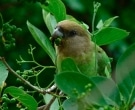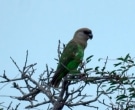Of 22 cm.. length and a weight between 120 and 156 g..
The Brown-headed Parrot (Poicephalus cryptoxanthus) has the head, including the nape, the chin and throat brown; ear-coverts paler. Mantle brown, but more to the tail; scapulars dark green-edged Brown; rump and uppertail-coverts bright green. Upper, the wing-coverts green, sometimes with a small yellow spot on the curve of the wing folded; wing feathers yellow. Primaries Brown with vane Blue-Green external; the secondaries brown.
The feathers in the upper area of the chest Brown with a narrow edge of green at the bottom; the rest of the underparts green, but darker bases of the feathers, giving a mottled look.
Tail dark brown with green washing and dark green tip.
The upper mandible and cere grey-black (darker towards tip), lower pale, almost white; irises yellow-green light; periophthalmic ring and legs dark grey to black.
Both sexes similar.
Immature generally more muted than adults and with the irises brown.
- Sound of the Brown-headed Parrot.
- Poicephalus cryptoxanthus cryptoxanthus (Peters,W, 1854) – Nominal species
- Poicephalus cryptoxanthus tanganyikae (Bowen, 1930) – As the nominal but more pale species; more green and less Brown. Green mantle and underparts brighter. Bib of brown feathers on the throat and upper of the much smaller chest than in the nominal species; the head more color olive brown.
Is located in almost all the forests: riparian forests, inside Savannah forests and dry forests in southeastern Africa, but it seems to avoid the miombo woodland and prefers areas with baobabs.
Registered in coconut plantations, riparian forest, the edges of small farms and mangroves.
Confined in lowlands (below the 1.200 metres above sea level in Tanzania and 1.000 metres in Malawi).
Gregarious; usually seen them is in small flocks of about 12 birds, but can meet up to 50 in places of power. Sometimes it is associated with the Cape Parrot and also observed feeding in company of the Madagascar Green-Pigeon.
Normally nest in hollows of old trees of woodpeckers, between 4 and 10 meters above the ground. Often has to compete with the Cape Parrot, Meyer's Parrot, squirrels and Crowned Hornbill the nesting sites.
Season of laying egg is April-May in the South of its range.
The laying is of 2 to 4 eggs, which are incubated solely by the female during 26-30 days, While the male feeds her on the nest.
The chicks they remain in the nest during 50-54 days before leaving to the “breeding ground”, It is generally an area with dense trees broadband supply of water in the vicinity. During this time the chicks are silent and largely immobile, becoming fully independent a few 28 days later.
Diet includes figs, berries cultivation of cassava Manihot esculenta, seeds of Adansonia, coconut palm flowers, new shoots of trees, fruits of Pseudocadia zambesica, pods of Acacia nigrescens and Albizia gummifera, immature seeds of Erythrina and nectar from flowers of Aloe and African Kigelia; also takes millet and maize and in some areas considered to be a pest.
They forage, with slow and deliberate movements, climbing and often holding the food between the claws. They drink daily, around noon.
The Brown-headed Parrot are distributed by the southeast of Africa. From the North-East of South Africa (Swaziland, Zululand and Transvaal) through the southeast of Zimbabwe, Mozambique and South of Malawi to the East of Tanzania (including the island of Pemba and southern end of Zanzibar) and southeastern edge of Kenya.
There are also in Wasini island.
Apparently sedentary. In some places, the Brown-headed Parrot, are a species common, especially close to the coast and in the South of its range, but in some other areas are scarce or rather local; in Zanzibar possibly extinct.
- Poicephalus cryptoxanthus cryptoxanthus (Peters,W, 1854) – Nominal species
- Poicephalus cryptoxanthus tanganyikae (Bowen, 1930) – Mozambique, to the North of the Save river across the South of Malawi and this from Tanzania to the coastal part of Kenya.
• Current red list of UICN: Least concern
• Population trend: Stable
It is not threatened, Although their distribution has shrunk from 1990, to a large extent due to the capture illegal for the industry of cage birds.
More and more vulnerable due to the loss and fragmentation of their habitat.
Largely confined to protected areas in Zululand and East of Transvaal.
The only data we have on this bird, According to sources, is that a specimen was still alive after 32,1 years in captivity.
- Brown-headed Parrot, Brown headed Parrot, Brownheaded Parrot (inglés).
- Perroquet à tête brune (francés).
- Braunkopfpapagei, Braunkopf-Papagei (alemán).
- Papagaio-de-cabeça-castanha (portugués).
- Lorito Cabecipardo, Lorito de Cabeza Parda (español).

- Orden: Psittaciformes
- Familia: Psittacidae
- Genus: Poicephalus
- Nombre científico: Poicephalus cryptoxanthus
- Citation: (Peters, W, 1854)
- Protónimo: Psittacus (Poiocephalus) [sic] cryptoxanthus
————————————————————————————————
Brown-headed Parrot (Poicephalus cryptoxanthus)
Sources:
– Avibase
– Parrots of the World – Forshaw Joseph M
– Parrots A Guide to the Parrots of the World – Tony Juniper & Mike Parr
– Birdlife
– Photos:
(1) – A Brown-headed Parrot at Kruger National Park, South Africa Henry Flower at en.Wikipedia [CC BY-SA 3.0 or GFDL], from Wikimedia Commons
(2) – Bungalow N ° 51, Mopani Camp, Kruger NP, SOUTH AFRICA By Bernard DUPONT from FRANCE (Brown-headed Parrot (Poicephalus cryptoxanthus)) [CC BY-SA 2.0], via Wikimedia Commons
(3) – A Brown-headed Parrot in KwaZulu-Natal, South Africa By New Jersey Birds (Brown-headed ParrotUploaded by snowmanradio) [CC BY-SA 2.0], via Wikimedia Commons
(4) – Bungalow N ° 51, Mopani Camp, Kruger NP, SOUTH AFRICA By Bernard DUPONT from FRANCE (Brown-headed Parrot (Poicephalus cryptoxanthus)) [CC BY-SA 2.0], via Wikimedia Commons
(5) – Lower Sabie Camp, Kruger NP, SOUTH AFRICA By Bernard DUPONT from FRANCE (Brown-headed Parrot (Poicephalus cryptoxanthus)) [CC BY-SA 2.0], via Wikimedia Commons
– Sounds: Peter Boesman (Xeno-canto)





